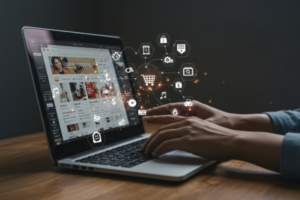Apparel and retail are facing a new reality and continuing to transform as the coronavirus pandemic remains in many parts of the world. Many fashion and apparel executives felt pessimistic about the future of retail at the onset of the pandemic – but the brands that have thrived the most are the ones that have maintained a strong-willed strategy and determination to survive.
While this industry saw significant losses in 2020, the opportunity for apparel and fashion brands to innovate and become a consumer favorite has never been higher. The global apparel market was worth a whopping $1.5 trillion last year and is expected to grow to $2.25 trillion by 2025.
In this infographic, you’ll uncover the latest fashion and apparel trends and stats, how the coronavirus pandemic has impacted this industry, and tips and strategies for apparel and retail brands in a fluctuating market.

Apparel Trends, Stats, & Metrics for 2021
- The fashion category was hit hard in 2020, with profits falling 93% for the year
- The global apparel market was wroth $1.5 trillion in 2020 and is expected to hit $3.3 trillion by 2030
- Overall digital sales are expected to grow 20% in 2021
- The athleisure category made up 20% of all apparel sales in 2020
- US ecommerce sales are expected to approach $100 billion in 2021
How COVID-19 has impacted some of the largest apparel retailers in the US
- GAP plans to double its online business by the end of 2023 and is building a $140 million warehouse to make it happen. At the same time, the retail giant is shutting roughly 30% of its North American stores.
- Kohl’s and Nordstrom Inc. saw significant online growth last year. Kohl’s was up 41% in 2020, with 40% of online orders picked up in-store. Ecommerce accounted for 55% of Nordstrom Inc.’s revenue in 2020, up from 33% in 2019.
Apparel strategies & tips for brands
- Think omnichannel. Omnichannel customers spend 4x more than store-only shoppers and 6x more than digital-only shoppers. As the pandemic subsides and consumers feel increasingly comfortable entering stores, retailers with brick-and-mortar locations have an extra opportunity to stand out and convert customers.
- BOPIS & curbside. 35% of online shoppers have used curbside pickup in the past six months, compared to 13% at this time last year. Consumers no longer have to spend time searching the store or waiting for shipping with the immediacy of BOPIS (buy online, pick up in store) and curbside pickup, making these attractive options for consumers looking to get their product quickly and hassle-free.
- Personalization. Mass marketing is no longer the way to convince customers to make a purchase. Consumers are looking for a hyper-personalized experience. By leveraging AI, brands can evolve their communication strategy and speak more specifically to different segments of their audience, leading to increased conversions.
- Apparel and retail are facing a new reality and continuing to transform as the coronavirus pandemic remains in many parts of the world. Many fashion and apparel executives felt pessimistic about the future of retail at the onset of the pandemic. Brands that have maintained a strong-willed determination to survive have thrived the most.
Sources
- McKinsey & Company, The State of Fashion.
- Statista, Global apparel market – statistics & facts.
- Statista, Apparel e-commerce market size in the United States from 2016 to 2021.
- Digital Commerce 360, How big retail chains fared online in 2020.




